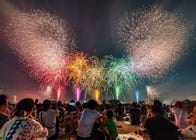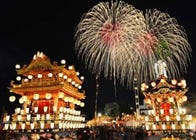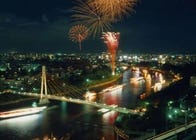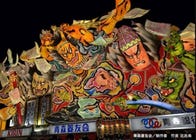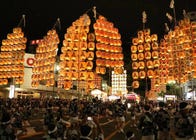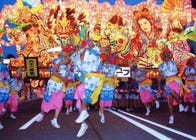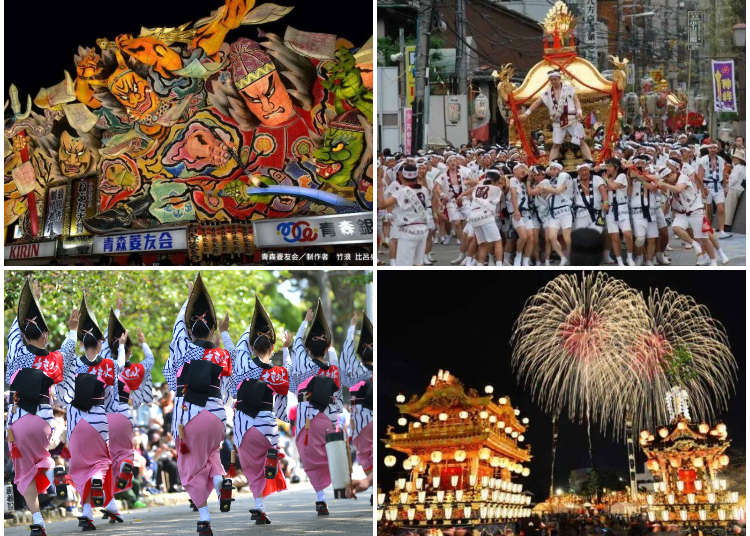
Immerse yourself in Japan's vibrant heritage with our regional guide to its most celebrated festivals, from the iconic Tenjin, Gion, and Kanda Matsuri to Aomori's Nebuta and Sendai's Tanabata – essential additions to your Japan travel itinerary!
- Table of Contents
Japan is known for its traditional festivals, or matsuri, which are deeply rooted in the regions and passed down by the locals. From the well-known "Three Great Festivals of Japan" (Tenjin Matsuri in Osaka, Gion Matsuri in Kyoto, and Kanda Matsuri in Tokyo) to the lively festivities of Aomori’s Nebuta Festival and Sendai’s Tanabata Festival, the country has a diverse range of celebrations.
This article is a compilation of famous festivals, introduced by region, that we recommend visiting while in Japan. Make sure to add them to your travel itinerary and experience the exciting celebrations during your trip!
Kanto Region
The Kanto region is a geographically diverse area located on the eastern side of Japan's main island, Honshu. It is the political and economic heart of the country, encompassing seven prefectures, including Tokyo, which is Japan's capital and the world's most populous metropolitan area. The region blends ultra-modern cities, such as Yokohama and Saitama, with traditional towns and natural landscapes, from the coastal areas of Chiba to the mountainous terrains of Gunma.
Kanto is known for its significant cultural sites, such as the historic temples in Kamakura and the natural hot springs of Hakone. The region also plays host to a variety of festivals, many of which take place at famous shrines and temples, including the Sanja Festival at Asakusa Shrine and Sensoji Temple in Tokyo, the Kanda Festival at Kanda Myojin Shrine, and the Chichibu Night Festival held at Chichibu Shrine in Saitama Prefecture. Each celebration is brimming with energy and excitement, and absolutely worth checking out!
Sanja Festival: A Lively Procession of Portable Shrines (May/Asakusa)
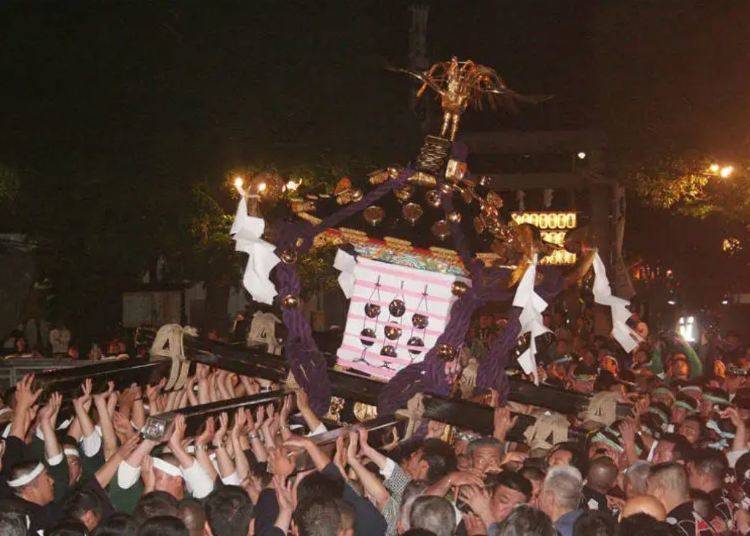
Overview
The Sanja Festival is one of Japan's most iconic festivals, drawing in nearly 1.8 million visitors over the course of three days. Typically held at the famous tourist destinations, Asakusa Shrine and Senso-ji Temple, this festival’s highlight is undoubtedly the procession of mikoshi, or portable shrines, held on the second and third days. Adorned in festive attire, participants shoulder the mikoshi as they parade through the streets of Asakusa. It’s said to be Asakusa’s busiest time of the year!
Festival Highlights
The festival reaches its peak with a lively mikoshi parade on the final day. The entire Asakusa area comes alive with excitement as three mikoshi from Asakusa Shrine are paraded through the streets before returning to the shrine for the Miyairi event. It's a novel sight for tourists to watch as the Japanese locals, typically reserved, out all their energy into carrying these mikoshi. The Dai-gyoretsu, or Grand Parade, held on the first afternoon, is another a must-see.
Dates:
Around May 17-18, Friday-Sunday.
-

-
Address
Around Asakusa Shrine, 2 Asakusa, Taito-ku, Tokyo, 111-0032
View Map -
Nearest Station
Asakusa Station (Tokyo Metro Ginza Line / Toei Asakusa Line / Tobu Isesaki Line (Tobu Skytree Line) / Tsukuba Express)
7 minutes on foot
- Phone Number 03-3844-1575
-
Address
Around Asakusa Shrine, 2 Asakusa, Taito-ku, Tokyo, 111-0032
Kanda Festival: A Must-See Mikoshi Miyairi at One of Japan’s Three Major Festivals (May/Kanda)
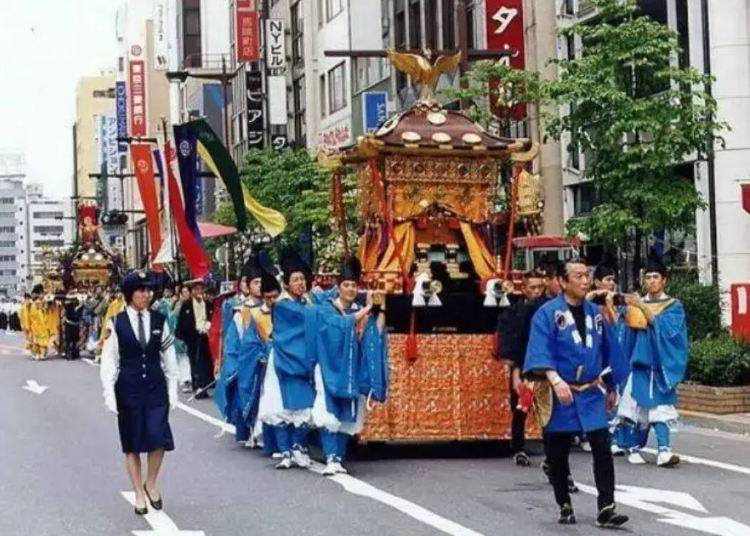
Overview
The Kanda Festival is another of Japan's three major festivals, together with Kyoto’s Gion Festival and Osaka’s Tenjin Festival. Held every two years at Kanda Myojin Shrine in Chiyoda Ward, Tokyo, this festival features a magnificent grand procession that travels through the local areas. The festival features a number of highlights, including the Shinkosai (a purification ceremony to cleanse the town) and the Tsuke-matsuri, a parade of floats, performances, and costumes.
Festival Highlights
The climax of the festival is the Mikoshi Miyairi, where the shrines are brought into the shrine in succession. At this time, the shrine precincts are brimming with excitement as the enthusiastic chants of the mikoshi bearers, with calls of "Wasshoi" and "Soiya" resound throughout the vicinity.
Dates:
Every other year, around May 15, Saturday-Sunday
-

-
Address
Chuo-dori (Akihabara) and others in Chiyoda-ku, Tokyo, 101-0021
View Map -
Nearest Station
Ochanomizu Station (JR Chuo Main Line / Tokyo Metro Marunouchi Line / JR Sobu Line)
5 minutes on foot
- Phone Number 03-3254-0753
-
Address
Chuo-dori (Akihabara) and others in Chiyoda-ku, Tokyo, 101-0021
Sanno Festival: A Spectacular 300-Meter Festival Parade (June/Asakusa)
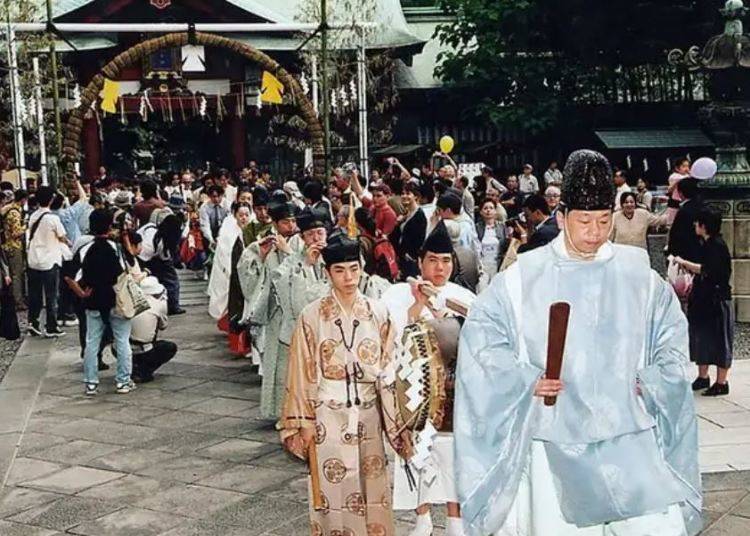
Overview
This is the collective name for the 20-plus festivals that take place around the annual festival held every June 15. It is one of the three major festivals of Edo, and is held at Hie Shrine in Tokyo's Chiyoda Ward. The festival period includes a variety of events such as the Chigo-gyoretsu (Children’s Parade) and the Kagura-bayashi (a performance of sacred music and dance).
Festival Highlights
The biggest attraction is the Shinkosai, In which two imperial palanquins, a mikoshi shrine, and three floats make rounds around the area. The procession, featuring 500 participants adorned in royal attire, captivates onlookers with its magnificent elegance.
Dates:
Every other year, June 7-17
-

-
Address
Hie Shrine, 2-10-5 Nagatacho, Chiyoda-ku, Tokyo, 100-0014
View Map -
Nearest Station
Tameike-Sanno Station (Tokyo Metro Ginza Line / Tokyo Metro Namboku Line)
5 minutes on foot
- Phone Number 03-3581-2471
-
Address
Hie Shrine, 2-10-5 Nagatacho, Chiyoda-ku, Tokyo, 100-0014
Fukagawa Hachiman Festival: A Dynamic Celebration with Water Splashing (August/Fukagawa)
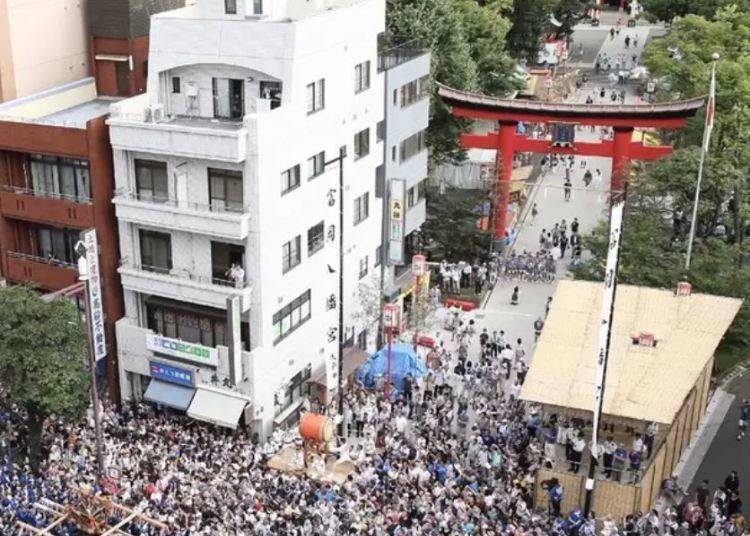
Overview
This festival, also known as the "Water-Throwing Festival," is an annual event held at Tomioka Hachiman Shrine. During the main festival, held once every three years, nearly 120 mikoshi are paraded throughout the neighborhood. The most spectacular part of the festival is the Rengo Togyo (a joint parade of portable shrines), featuring 53 large mikoshi and the Horen, a sacred palanquin adorned with a golden phoenix on the roof.
Festival Highlights
As the shrine bearers pass by, with their enthusiastic chants of "Wasshoi, Wasshoi," spectators along the route splash them with purifying water. This interactive event allows onlookers to join the shrine bearers in the celebration, creating an immersive experience in a traditional Japanese celebration.
Dates:
Usually held around August 15
-

-
Address
Tomioka Hachimangu, 1-20-3 Tomioka, Koto-ku, Tokyo, 135-0047
View Map -
Nearest Station
Monzen-Nakacho Station (Tokyo Metro Tozai Line / Toei Oedo Line)
3 minutes on foot
- Phone Number 03-3642-1315
-
Address
Tomioka Hachimangu, 1-20-3 Tomioka, Koto-ku, Tokyo, 135-0047
Tokyo Koenji Awa Odori: Exciting the Onlookers with Spectacular Dance (August/Koenji)
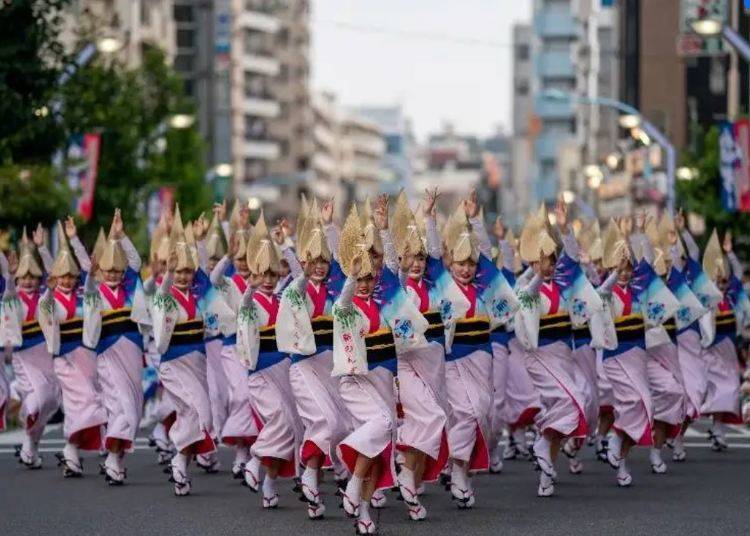
Overview
Awa Odori is a long-standing regional performance art with a history spanning over 400 years, originating in Tokushima Prefecture, Shikoku. The Tokyo Koenji Awa Odori was started in 1957 by the youth of Koenji as a way to revitalize the local shopping district. In this event, over 10,000 dancers take to the streets with enthusiasm, moving to the upbeat music of flutes, drums, and shamisen.
Festival Highlights
The dancers perform together with spirited chants of "Yatto-sa, Yatto Yatto!” It’s quite a sight to behold, attracting over a million spectators, and showcasing distinct Japanese elements like straw hats, fans, and wooden clogs.
Dates:
Late August, Saturdays and Sundays
-

-
Address
Koenji Sta., JR Koenji Station, Suginami Ward, Tokyo, 166-0003
View Map -
Nearest Station
Koenji Station (JR Chuo Main Line)
- Phone Number 03-3312-2728
-
Address
Koenji Sta., JR Koenji Station, Suginami Ward, Tokyo, 166-0003
Chichibu Night Festival: Spectacular Fireworks and Float Competitions (December/Chichibu City)
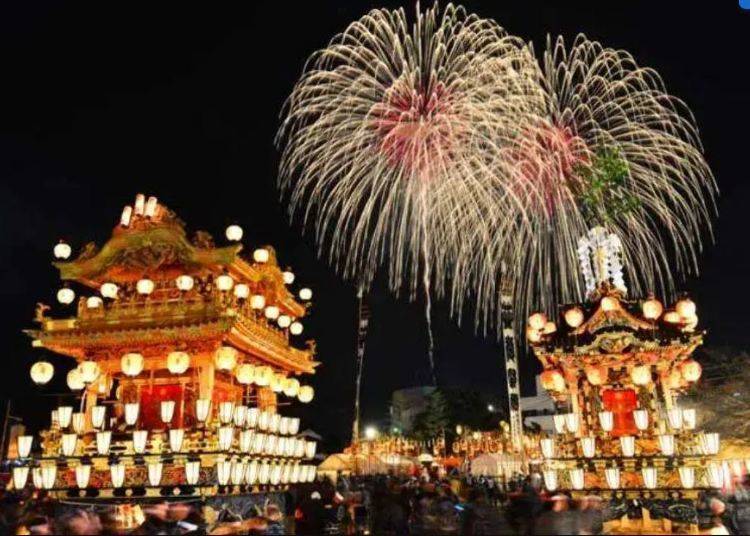
Overview
The Chichibu Night Festival is one of Japan's three major hikiyama (float) festivals, together with Kyoto's Gion Festival and Hida's Takayama Festival, held at Chichibu Shrine in Chichibu City. The term “hikiyama” refers to the ornate floats that parade along the main street during the Yoi-miya procession. During this event, things get exciting as four of these floats are pulled past each other in such close proximity, they appear as if they’re about to collide! On the following day, during the Dai-matsuri (Grand Festival), two magnificent “kasaboko" floats and four “yatai" floats make their rounds in the streets, accompanied by the music of the Chichibu floats.
Festival Highlights
The climax unfolds on the night of December 3rd, when massive kasaboko floats weighing up to 20 tons are hauled up the steep slope known as Dangozaka. This is said to be the most demanding part of the festival, with numerous participants working up a sweat as they pull the floats along, while spectators hold their breath in awe.
Dates:
Yoi-miya: December 2
Dai-matsuri: December 3
-

-
Address
Chichibu-shi, Saitama Banba 1-3, 368-0041
View Map -
Nearest Station
Chichibu Station (Chichibu Railway)
3 minutes on foot
- Phone Number 0494-22-0262
-
Address
Chichibu-shi, Saitama Banba 1-3, 368-0041
Kansai Region
The Kansai region, also known as the Kinki region, is located in the southern-central region of Japan's main island, Honshu. It is a culturally rich and historically significant area that has played a central role in Japanese history for thousands of years. Kansai encompasses several prefectures, including Osaka, Kyoto, Nara, Hyogo, Wakayama, Mie, and Shiga.
Often considered the cultural heart of Japan, Kansai is renowned for its ancient capitals. Kyoto, once the imperial capital of Japan, is famous for its classical Buddhist temples, as well as gardens, imperial palaces, Shinto shrines, and traditional wooden houses. Nara, also a former capital, is known for its monumental statues of Buddha, historic temples, and Nara Park with its freely roaming deer. Osaka, the modern metropolis and commercial hub of the region, is known for its vibrant nightlife, modern architecture, and hearty street food.
In addition to cultural treasures, you'll find a number of historic traditional events and festivals that have been passed down to the current generation, such as the long-running Tenjin Festival and Gion Festival, which can run for as long as an entire month!
Aoi Festival: A Spectacle from the Heian Period (May/Kyoto)
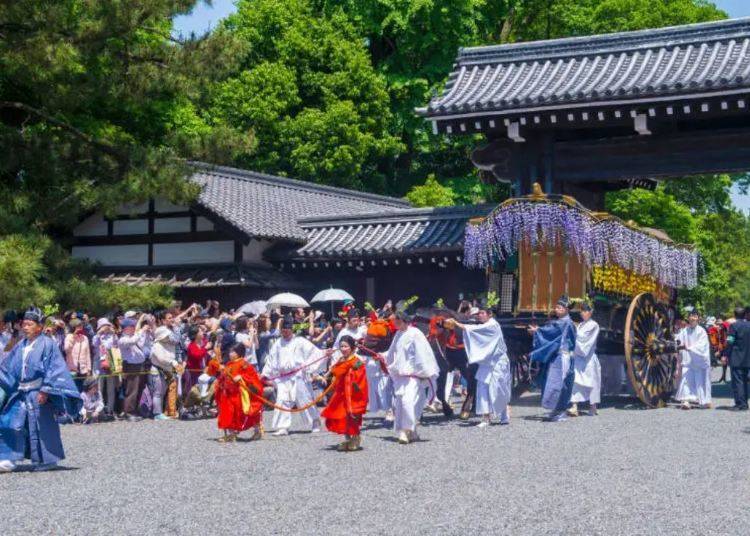
Overview
This festival takes place at Kamo Shrine (Shimogamo Shrine) and Kamo-wake-ikazuchi-jinja (Kamigamo Shrine) in Kyoto. Over 500 participants dressed in Heian aristocratic attire parade from the Kyoto Imperial Palace to Shimogamo Shrine and Kamigamo Shrine. On May 3rd, there’s also the Yabusame Shinji event, held at the Shimogamo Shrine to pray for the safety of the procession.
Festival Highlights
The grand procession is divided into "Hon-retsu" (the main parade) and "Saiodai-retsu" (the procession of the Saio, the "Festival Maiden”). The Saiodai-retsu is a particularly spectacular event, featuring the Saio (a woman representing an Imperial Princess) riding a palanquin, sa well as shrine maidens, court ladies, and other officials, all dressed in exquisite attire and carrying musical instruments. It’s an impressive scene from right out of a Heian-period picture scroll!
Dates:
May 15
-

-
Address
59, Shimogamoizumigawacho, Sakyo-ku, Kyoto-shi, Kyoto, 606-0807
View Map -
Nearest Station
Demachiyanagi Station (Eizan Dentetsu Eizan Line)
10 minutes on foot
- Phone Number 075-781-0010
-
Address
59, Shimogamoizumigawacho, Sakyo-ku, Kyoto-shi, Kyoto, 606-0807
-

-
Address
339, Kamigamomotoyama, Kita-ku, Kyoto-shi, Kyoto, 603-8047
View Map -
Nearest Station
Kitaoji Station (Karasuma Line)
10 minutes by bus
- Phone Number 075-781-0011
-
Address
339, Kamigamomotoyama, Kita-ku, Kyoto-shi, Kyoto, 603-8047
Tenjin Festival: Magnificent Mikoshi and Fireworks at One of Japan's Three Great Festivals (June-July/Osaka)
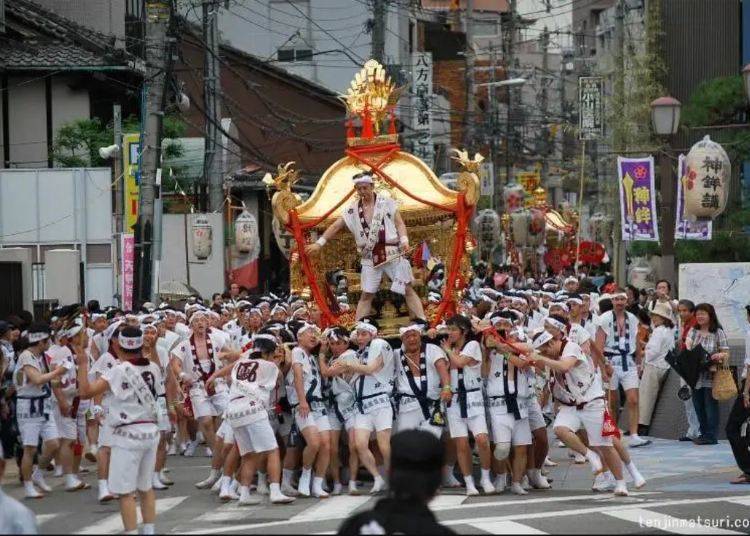
Overview
The Tenjin Festival is one of Japan’s three greatest festivals, together with Tokyo’s Kanda Festival and Kyoto’s Gion Festival. Held at Osaka Tenmangu Shrine, this event lasts nearly an entire month, from late June to July 25. Various events take place during this festival, with one of the most exciting days being July 25, when grand processions grace both the streets and the river! The evening boasts its own distinct festive vibe, as celebratory fireworks light up the sky alongside bonfires and lanterns.
Festival Highlights
One must-see is the Riku-togyo (land parade) held on July 25. A large procession of nearly 3,000 people departs from Osaka Temmangu Shrine, parading to the riverside. Dressed in bright, colorful costumes and carrying sacred objects, it resembles a scene from an Edo picture scroll. It culminates with a finale of nearly 5,000 fireworks, a truly magnificent sight to behold!
Dates:
From late June to July 25
-

-
Address
Tenjinbashi, Kita-ku, Osaka-shi, Osaka, 530-0041
View Map -
Nearest Station
Tenjimbashisujirokuchome Station (Tanimachi Line / Sakaisuji Line / Hankyu-senri Line)
3 minutes on foot
- Phone Number 06-6353-0025
-
Address
Tenjinbashi, Kita-ku, Osaka-shi, Osaka, 530-0041
Gion Festival: A Moving Art Museum Parades Through the Streets at One of Japan's Three Great Festivals (July/Kyoto)
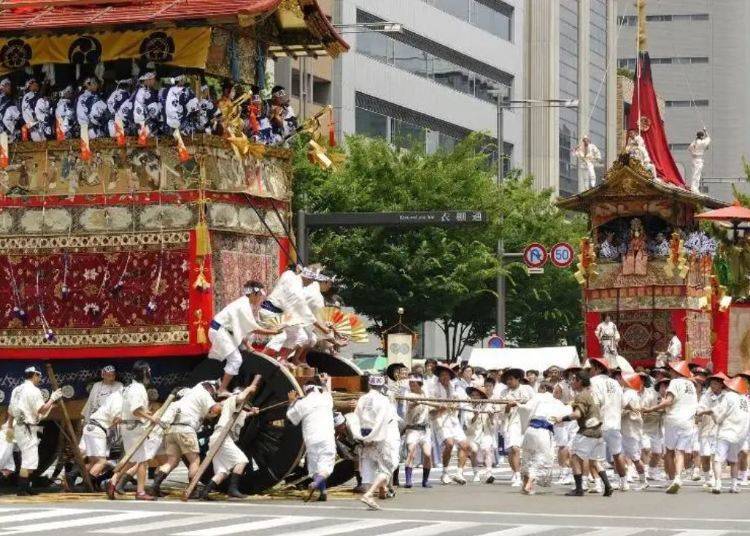
Overview
Another of Japan’s three great festivals, the Gion Festival, is an annual festival held at Yasaka Shrine in Kyoto. It takes place throughout July, from the 1st to the 31st, enveloping the entire city of Kyoto in a festive atmosphere. One highlight of this event is the Yamaboko Junko (held July 17), a parade featuring lavishly decorated floats known as “Yama” and “Hoko.” On that evening, Yoiyama is celebrated with an array of street stalls lining the venue.
Festival Highlights
The beauty of the uniquely Japanese yamaboko floats, adorned with exquisite carpets, tapestries, and more, is a captivating sight for foreign visitors. Some floats even use imported fabrics like Gobelins tapestries and Nishijin textiles. As you watch the parade, an array of artworks come to life right before you, a spectacle that has earned these floats the nickname, the “Moving Art Museum.”
Dates:
July 1-31
-

-
Address
Yasaka Shrine and others, Kyoto Prefecture Higashiyama Ward, Kyoto City, 605-0000
View Map -
Nearest Station
Kyoto Station (JR Tokaido Line / JR Biwako Line / JR Tokaido Shinkansen / JR Kyoto Line / JR Sagano Line / JR San-in Line / JR Nara Line / Karasuma Line / Kintetsu-kyoto Line)
20 minutes by bus
- Phone Number 075-561-6155
-
Address
Yasaka Shrine and others, Kyoto Prefecture Higashiyama Ward, Kyoto City, 605-0000
Kyoto Gozan Okuribi: Flaming Lettering Illuminates the Mountains (August/Kyoto)

Overview
This traditional event takes place on various mountains throughout Kyoto every year on August 16. It begins with the lighting of Daimonji Okuribi at 8 PM, followed by four other fires lit at five-minute intervals, including the the Matsugazaki Myoho Okuribi (Sakyo Ward) and the Funagata Mantoro Okuribi (Kita Ward). For those who want to watch the spectacle up close, the Kamo River riverbed between Imadegawa-dori and Kitaoji-dori offers a great view!
Festival Highlights
Kanji characters are set ablaze on the mountains of Higashiyama, Matsugasaki, Nishi-Kamo, Daikichi-yama, and Saga: 大 (Dai) on Higashiyama, 妙 (Myo) and 法 (Ho) on Matsugazaki, 船形 (Funagata) on Nishigamo, 左大文字 (Sa-Daimonji) on Daikokuyama, and 鳥居形 (Torii-gata) in Saga. Watch as these characters dramatically come to life through fire as you experience one of Japan’s most unique traditions!
Dates:
August 16
-

-
Address
5 locations in Sakyo Ward, Kyoto City, Kyoto Prefecture, 606-0000
View Map -
Nearest Station
Kitaoji Station (Karasuma Line)
- Phone Number 075-343-0548
-
Address
5 locations in Sakyo Ward, Kyoto City, Kyoto Prefecture, 606-0000
Kishiwada Danjiri Festival: The Spectacular Danjiri Parade (September-October/Kishiwada)
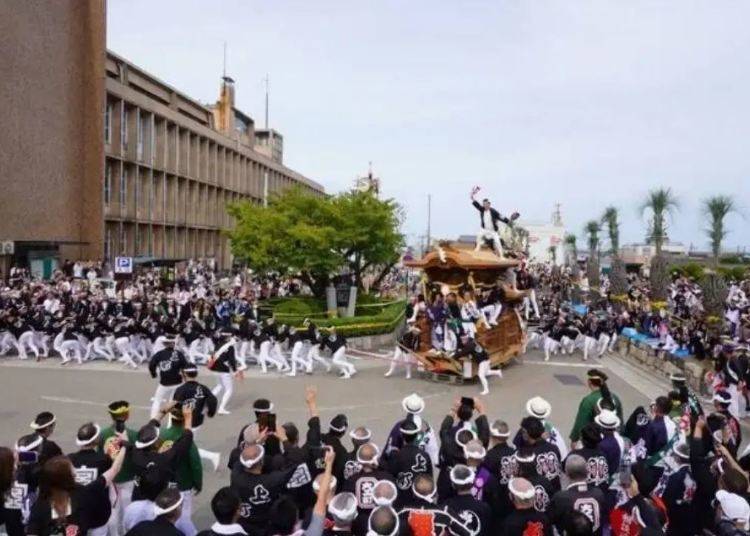
Overview
This traditional event, held in the vicinity of the Nankai Electric Railway’s Kishiwada Station in Osaka, features an awe-inspiring spectacle of men hauling enormous danjiri floats through the streets with two thick ropes, some as heavy as 4 tons! During the 2023 event, 34 danjiri floats joined in from a number of districts within the city. These danjiri floats are intricately adorned with ornaments and carvings, often regarded as “moving works of art” for their creativity.
Festival Highlights
The biggest highlight of this festival is the yarimawashi, when the massive danjiri floats, exceeding 4 meters in height and 4 tons in weight, make sharp 90-degree turns while parading at full speed. In the daytime, these massive floats race through the streets, while they slow down at night, and lanterns are lit for a more graceful, elegant vibe.
Dates:
Mid-September and early October, Saturday-Sunday
-

-
Address
Various places in Kishiwada City, Osaka Prefecture, 596-0000
View Map -
Nearest Station
Kishiwada Station (Nankai Airport Line / Nankai Line)
- Phone Number 072-423-9486
-
Address
Various places in Kishiwada City, Osaka Prefecture, 596-0000
Jidai Festival: A Magnificent Parade of 2,000 Participants (October/Kyoto)
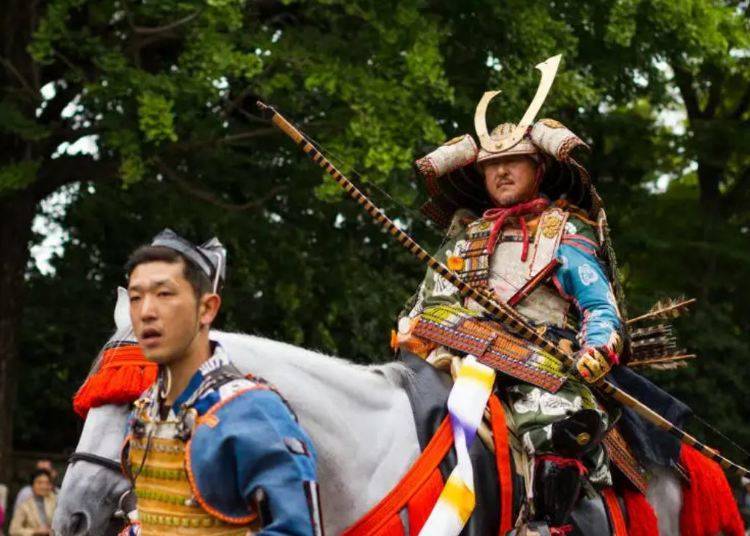
Overview
Held annually on October 22 at Heian Shrine in Kyoto, the Jidai Festival is a grand event highlighted by a lengthy historical procession spanning nearly 2 kilometers. Starting from the front of Kyoto Imperial Palace Kenninmon and ending at Heian Jingu Shrine. This procession comprises 20 segments representing eight historical periods, including the Meiji Restoration, the Edo Period, and the Azuchi-Momoyama Period, giving spectators a look into part of Japan's history.
Festival Highlights
Spectators will be impressed by the costumes, ritual objects, and accessories worn and held by the paraders. There are as many as 12,000 meticulously recreated and historically accurate items on display, each reflecting their respective periods.
Dates:
October 22
-

-
Address
Various places in Sakyo Ward, Kyoto City, Kyoto Prefecture, 606-0000
View Map -
Nearest Station
Kyoto Station (JR Tokaido Line / JR Biwako Line / JR Tokaido Shinkansen / JR Kyoto Line / JR Sagano Line / JR San-in Line / JR Nara Line / Karasuma Line / Kintetsu-kyoto Line)
30 minutes by bus
- Phone Number 075-761-0221
-
Address
Various places in Sakyo Ward, Kyoto City, Kyoto Prefecture, 606-0000
Tohoku Region
The Tohoku region is the northeastern portion of Japan's Honshu Island, characterized by its rugged mountain landscapes, scenic beauty, rich folklore, and distinct seasons. The region consists of six prefectures: Aomori, Akita, Iwate, Yamagata, Miyagi, and Fukushima.
Tohoku is less densely populated and more rural compared to many other regions of Japan, offering a more tranquil and untouched landscape.
Historically, Tohoku has been seen as a remote and harsh area, but it can be said that this very remoteness has preserved many of its traditional customs, festivals, and crafts. The region is known for having some of the country's most vibrant festivals, like the Aomori Nebuta Festival, Akita's Kanto Festival, and Sendai's Tanabata Festival, which are vibrant displays of local culture and history.
Akita Kanto Festival: Radiant Lanterns Illuminate the Venue (August/Akita City)
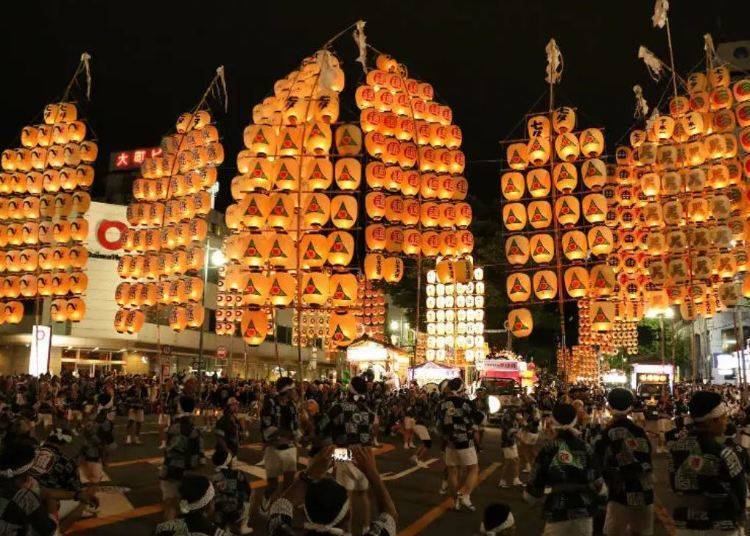
Overview
As one of the three major festivals of Tohoku (together with the Aomori Nebuta Festival and the Sendai Tanabata Festival), this ritual is held to pray for good luck and a bountiful harvest. In the climactic main event at night, the venue is lit with the radiant lights of nearly 280 Kanto lanterns hanging from long bamboo poles.
Festival Highlights
The highlight of this festival is the remarkable skill of the lantern holders, each individually carrying an enormous 12-meter, 50-kilogram kanto pole, and passing it between their hands, shoulders, and waists. Around 8:30 PM, after the performance has ended, the general public can even touch the kanto poles themselves!
Dates:
August 3-6
-

-
Address
Around Kanto Odori, Akita City, Akita Prefecture, 010-0000
View Map -
Nearest Station
Akita Station (Ou Line / Akita Shinkansen / Uetsu Line)
15 minutes on foot
- Phone Number 018-888-5602
-
Address
Around Kanto Odori, Akita City, Akita Prefecture, 010-0000
Sendai Tanabata Festival: An Entire Town Adorned in Bamboo Decorations (August/Sendai City)
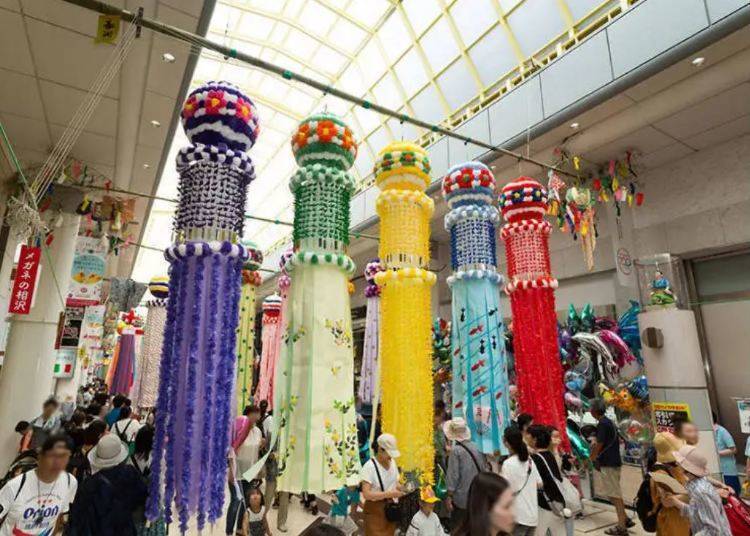
Overview
This event takes place in Sendai, the central city of the Tohoku Region. Throughout the festival period, the city is adorned with colorful Tanabata decorations, drawing in over 2 million visitors every year. On the eve of the celebration, the Sendai Tanabata Fireworks Festival is also held, with nearly 16,000 dazzling fireworks lighting up the night sky.
Festival Highlights
The bamboo grass decorations are a must-see part of the event, displayed along the arcade street extending from JR Sendai Station’s West Exit. These decorations are handmade by the locals using washi paper, with wishes for prosperity in business, amongst other things. So take a stroll along the street, and check out these elaborate hanging decorations!
Dates:
August 6-8
-

-
Address
Sendai-shi, Miyagi center and neighboring malls, 980-0000
View Map -
Nearest Station
Sendai Station (Namboku Line)
- Phone Number 022-265-8185
-
Address
Sendai-shi, Miyagi center and neighboring malls, 980-0000
Aomori Nebuta Festival: Enormous Lantern Parade Throughout the City (August/Aomori City)
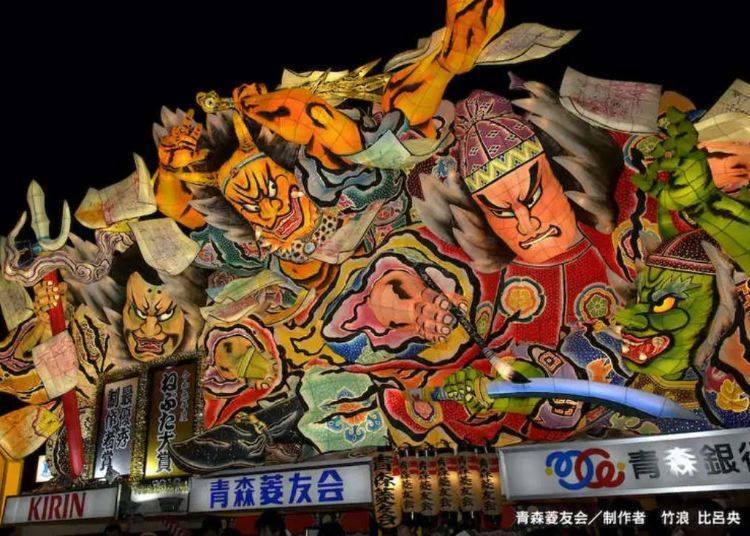
Overview
This traditional summer festival is held in Aomori City every August. The festival features gigantic lantern floats called “nebuta,” some as big as 5 meters tall and 9 meters wide, parading through the city. Joining the parade are performers known as Haneto, dancing with lively chants of “Rassera, Rassera!”
Festival Highlights
On the 7th, the last day of the event, the massive nebuta floats are paraded around in the daytime, leading up to the spectacular display of nebuta floats on the water in the evening, casting a different, enchanting allure in comparison to the daytime procession.
Dates:
August 2-7
-

-
Address
Aomori Chamber of Commerce Hall 4F, 1-2-18 Shinmachi, Aomori City, Aomori Prefecture, 030-0801
View Map -
Nearest Station
Aomori Station (Ou Line / Tsugaru Line / Aoimori Tetsudo)
3 minutes on foot
- Phone Number 017-723-7211
-
Address
Aomori Chamber of Commerce Hall 4F, 1-2-18 Shinmachi, Aomori City, Aomori Prefecture, 030-0801
Chubu Region
The Chubu region, or Central Honshu, is located in the heart of Japan’s main island and encompasses nine prefectures: Aichi, Fukui, Gifu, Ishikawa, Nagano, Niigata, Shizuoka, Toyama, and Yamanashi.
Culturally, the Chubu region is rich and varied. Kanazawa in Ishikawa prefecture is known for its well-preserved Edo-era districts, art museums, and regional handicrafts. Takayama and Shirakawa-go in Gifu offer a glimpse into Japan’s rural past, with traditional gassho-zukuri farmhouses.
Chubu is home to several spectacular festivals, such as the Inuyama Festival, featuring mechanical puppets dancing on gorgeous festival floats. There’s also dynamic celebrations like the Gujo Odori in Gifu Prefecture, where dancers perform all night long over the course of four days. Here are some of the most exciting events.
Takayama Festival: Magnificent Float Processions in the Spring and Fall (April & October/Gifu Prefecture)
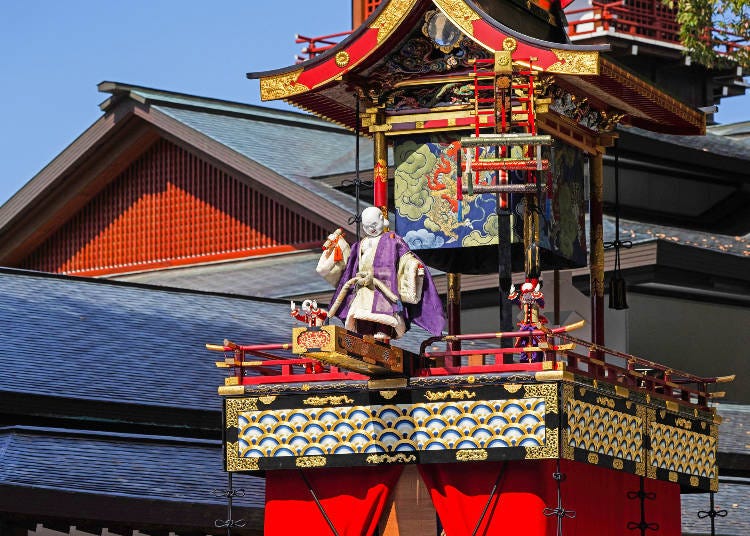
Overview
The Takayama Festival combines two festivals: the Spring Takayama Festival (Sanno Festival) on April 14-15 and the Autumn Takayama Festival (Hachiman Festival) on October 9-10. Ranked amongst Japan's top three beautiful festivals, the former takes place at the Hie Shrine in Takayama, Gifu Prefecture, while the latter occurs at Sakurayama Hachimangu Shrine in Takayama. Lavish festival floats showcase the craftsmanship of Hida as they parade through the streets, departing from Hie Shrine in the spring, and from Sakurayama Hachimangu Shrine in autumn.
Festival Highlights
The highlight of this event is the Karakuri Hono, where karakuri dolls (mechanical puppets) emerge from the floats, manipulated by several dozen ropes to move as if they were truly alive! The Night Festival brings spectators a different vibe, in which nearly 100 lantern-lit stalls illuminate the town in a magical ambiance.
Dates:
Sanno Festival: April 14-15
Hachiman Festival: October 9-10
-
Hie Shrine日枝神社
- Address 156, Shiroyama, Takayama City, Gifu, 506-0822
-
Sakurayama Hachiman Shrine櫻山八幡宮
- Address 178, Sakuramachi, Takayama City, Gifu, 506-0858
Shikoku Area
Shikoku is the smallest of Japan’s four main islands, located to the south of Honshu and east of Kyushu, separated from the former by the Seto Inland Sea. It consists of four prefectures: Ehime, Kagawa, Kochi, and Tokushima. Known for its warm climate, mountainous interior, and rugged Pacific coastline, Shikoku remains somewhat off the beaten path for international tourists, offering a serene, more intimate glimpse of Japanese regional culture.
Shikoku also boasts a number of dynamic, passionate festivals, including the Awa Odori, the Yosakoi Festival, and the Niihama Taiko Festival. Known as the three major festivals of Shikoku, these events are so vibrant and full of energy,that you can’t help but want to join in yourself!
Awa Odori: Japan's Largest Bon Dance Festival (August/Tokushima Prefecture)
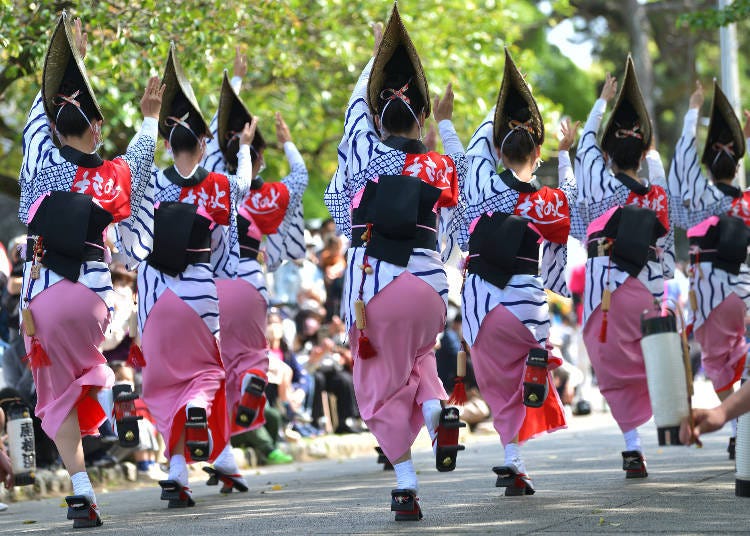
Overview:
With a history of over 400 years, the summer festival in Tokushima Prefecture takes place over four days, from August 12-15. It’s known for the Awa Odori, one of Japan’s three major bon dances, performed at various spaces throughout Tokushima City. Performers join dance troupes known as “Ren,” of which nearly 1,000 of these groups take part every year!
Festival Highlights
In addition to dancing, the inclusion of traditional Japanese instruments like taiko drums, gongs, bamboo flutes, and shamisen only adds to the appeal for foreign visitors. Spectators also love the distinct Japanese style of the participants, wearing kimono, yukata, straw hats, and wooden clogs, and carrying paper lanterns.
Dates:
August 12-15
-
Aibahama Performance Hall藍場浜演舞場
- Address 1-7, Aibacho, Tokushima City, Tokushima, 770-0835
Admission: Free, with the option of paid special seats
Yosakoi Festival: Merrily Dancing to the Sounds of Naruko (August/Kochi Prefecture)
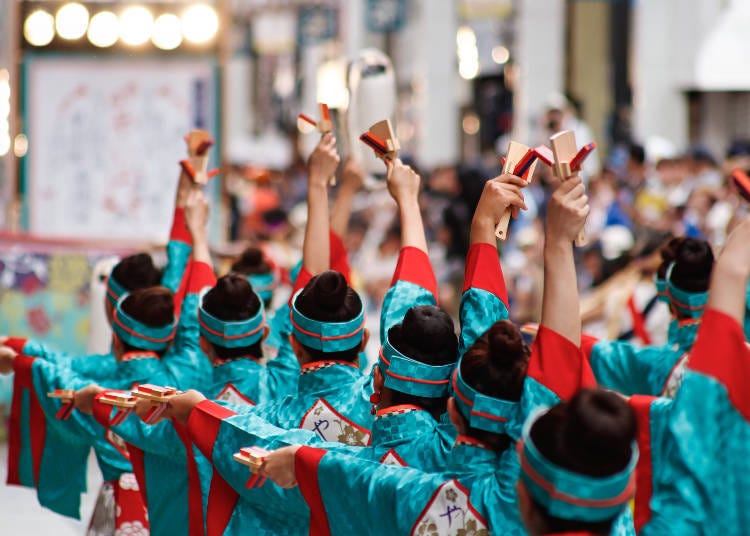
Overview:
This major event of Kochi Prefecture spans four days, starting with a fireworks display on the eve of the event, and upbeat dances performed at 17 venues and stages across the city. During the main Yosakoi Festival (August 10-11), nearly 20,000 dancers divided into about 190 teams bring the event to life with their performances.
Festival Highlights
Musical genres range from traditional to rock, with choreography that includes elements of hip-hop and rap. Dances and costumes exhibit a variety of styles, with no strict rules governing the performances. Spectators will be impressed at the synchronized movements of groups made up of as many as 100 dancers!
Dates:
August 9-12
-
Yosakoi Festival Otesuji Headquarters Concert Hallよさこい祭り追手筋本部競演場
- Address 2-1-12, Otesuji, Kochi City, Kochi, 780-0842
Niihama Taiko Festival: Giant Taiko Drums Parade Through the City (October/Ehime)
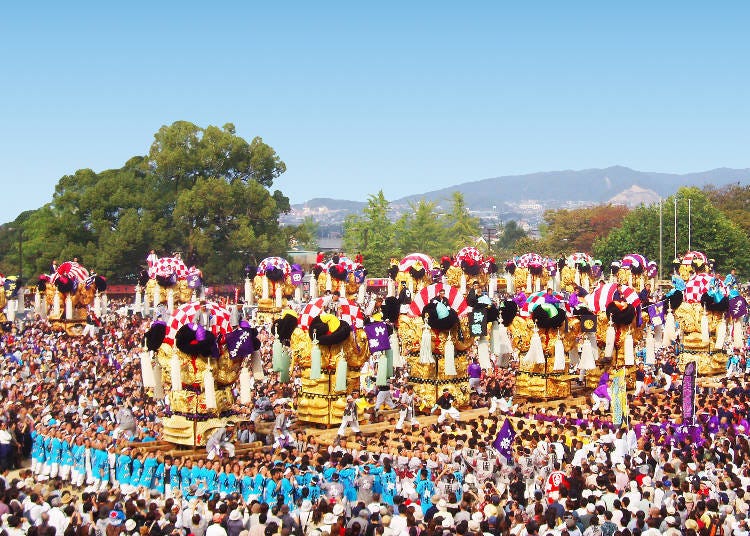
Overview:
This iconic festival of Ehime Prefecture dates back to the Heian Period. About 50 floats, known as “taiko-dai,” parade vigorously through the city, weighing nearly 3 tons each and towering at a height of almost 5.5 meters! These taiko-dai are adorned with intricately embroidered golden futon ties and curtains, resulting in a truly amazing sight!
Festival Highlights
Accompanied by chants of “Sorya, Sorya,” over 150 men must coordinate to lift the taiko-dai overhead in a spectacle known as “sashiage.” This is a must-see event, often resulting in tremendous cheers from the audience and a sense of unity throughout the area. Such displays of heroic strength have earned it the nickname “Men’s Festival.”
Dates:
October 15-18
-
Yamane Ground山根グラウンド
- Address 3-13, Suminoshindencho, Niihama City, Ehime, 792-0844
Hokkaido Region
Hokkaido is Japan's northernmost island and its largest prefecture, known for its vast wilderness, ski resorts, and agriproducts.
Hokkaido is a region with a relatively short history in comparison to Kyoto and Tokyo, so it tends to have fewer centuries-old traditions and festivals. However, given its location in the snowy north, there are a variety of unique events and festivities celebrating the long, harsh winters, such as snow and ice festivals. There are also distinct local festivals like Hokkai-Heso Matsuri in Furano City, and Noboribetsu Jigoku Matsuri in Noboribetsu Onsen.
Sapporo Snow Festival: Giant Sculptures of Snow and Ice (February/Sapporo City)
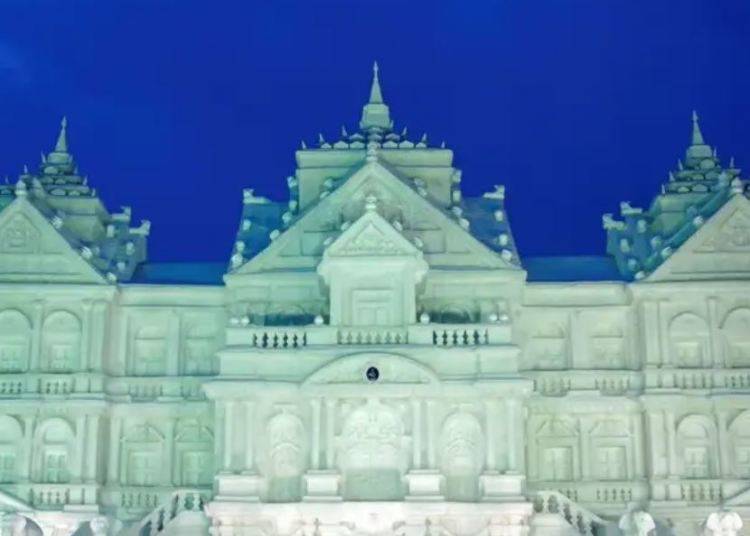
Overview:
This major winter event has been held in Sapporo since 1950, featuring over 200 snow statues of various sizes on display at the Odori and Susukino venues. Every year, an impressive 30,000 tons of snow are collected for these sculptures, which are then handcrafted by artisans using heavy machinery. Some snow statues are based on World Heritage Sites or Japanese and Hokkaido culture, while others take on a more unique approach, depicting characters from anime and manga.
Festival Highlights
At the Odori Site, you’ll find food stalls with Hokkaido delicacies like ramen and jingisukan (a local grilled mutton dish). And when night falls, the snow sculptures are beautifully illuminated, casting a magical, wondrous ambiance.
Dates:
Early February, about one week long
-

-
Address
Various places in Sapporo city, Hokkaido, 060-0042
View Map -
Nearest Station
Odori Station (Namboku Line / Tozai Line / Toho Line)
- Phone Number 011-281-6400
-
Address
Various places in Sapporo city, Hokkaido, 060-0042
Hokkaido Jingu Festival: Floats and Mikoshi Parade Through the City (June/Sapporo City)
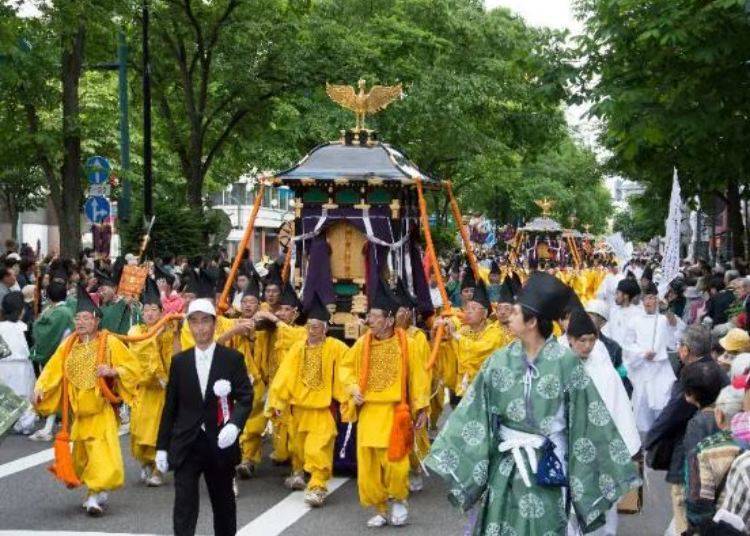
Overview:
Held in June at the Hokkaido Shrine in Sapporo, this festival boasts a history of over 100 years. The main event on the 16th, known as Mikoshi Togyo, features citizens donning costumes reminiscent of Heian picture scrolls, as well as four mikoshi and eight floats bearing deities, parading down the city in a procession spanning roughly a kilometer in length!
Festival Highlights
In addition to the Mikoshi Togyo, Hokkaido Shrine hosts a medley of other traditional events. You’ll also find a number of food stalls dotting the shrine grounds and Nakajima Park, where you can enjoy festival delights like yakisoba and cotton candy.
Dates:
June 14-16
-

-
Address
474 Miyagaoka, Chuo-ku, Sapporo-shi, Hokkaido, 064-0959
View Map -
Nearest Station
Maruyama koen Station (Tozai Line)
15 minutes on foot
- Phone Number 011-611-0261
-
Address
474 Miyagaoka, Chuo-ku, Sapporo-shi, Hokkaido, 064-0959
Kyushu Region
Kyushu, an island located immediately southwest of the main island of Honshu, comprises of seven prefectures: Fukuoka, Saga, Nagasaki, Kumamoto, Oita, Miyazaki, and Kagoshima. Kyushu is a popular destination in Japan, known for its beautiful beaches, breathtaking natural sights, hot springs, and rich history.
Kyushu is also home to a number of well-known festivals, including Fukuoka's Hakata Dontaku Port Festival and the Hakata Gion Yamakasa Festival. In northern Kyushu, there’s also an autumn festival known as Kunchi. Many festivals in this region have been long-loved by the local communities, and have been passed down though the generations.
Nagasaki Kunchi: A Grand Festival of Ship Parades and Dragon Dances (October/Nagasaki)

Overview:
With a history spanning approximately 390 years, this autumn festival is held at Suwa Shrine in Nagasaki City, Nagasaki Prefecture, over the course of three days (October 7-9). In addition to Suwa Shrine, festivities are also held at three other venues, including Yasaka Shrine and Central Park, where you can see the Kasaboko, a grand umbrella float adorned with hoko (spears), naginata, and decorative flowers, and traditional Japanese dances like Hon Odori (admission fees apply).
Festival Highlights
The main attraction of this festival is the Odoricho, where ceremonial dances are performed by the town in charge of that year’s festival. These include classic dances like Nihon Buyo synchronized to traditional Nagauta music, and the impressive Hikimono, a wheeled float pulled along by a large group of people.
Dates:
October 15-18
-
Chinzei Grand Shrine Suwa Shrine諏訪神社
- Address 18-15, Kaminishiyamamachi, Nagasaki City, Nagasaki, 850-0006
Karatsu Kunchi: A Spectacular Procession of Beautiful Floats (November/Saga)
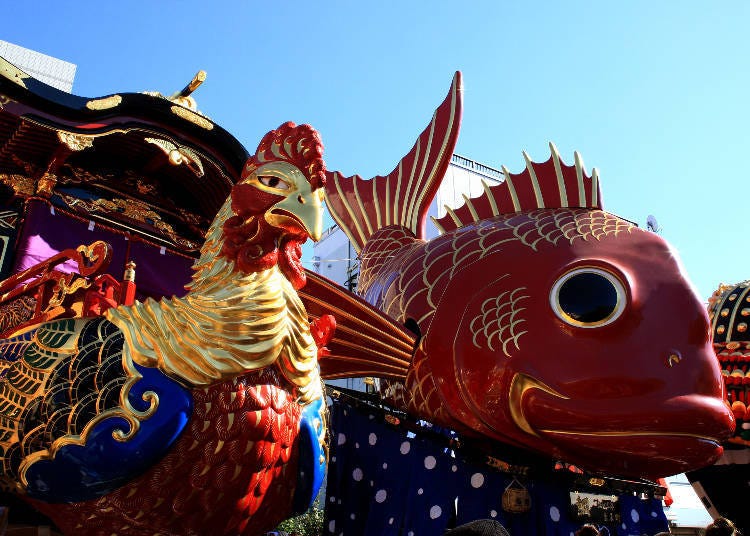
Overview:
Karatsu Kunchi is an autumn festival celebrated at Karatsu Shrine in Karatsu, Saga Prefecture. The town comes alive with 14 magnificent floats crafted into impressive shapes like fish and lions, made by layering washi paper and hemp cloth, and finished with a touch of lacquer. During the procession, flutes, bells, and drums beat to a lively cadence as the floats parade through the city.
Festival Highlights
The evening of November 2nd marks the Yoiyama event, in which the floats of each town join together in a procession to Karatsu Shrine in preparation for the next day’s parade. It’s a mesmerizing sight as the lanterns of the 14 floats illuminate the sky. The main attraction is called Otabisho Shinko, held on November 3rd. At this time, all 14 floats parade through the city and make a grand entrance as they are pulled across Nishinohama Beach.
Dates:
November 2-4
-
Karatsu Shrine唐津神社
- Address 3-13, Minamijonai, Karatsu City, Saga, 847-0013
Hakata Gion Yamakasa: Dashing Through the Town at Dawn (July/Fukuoka)
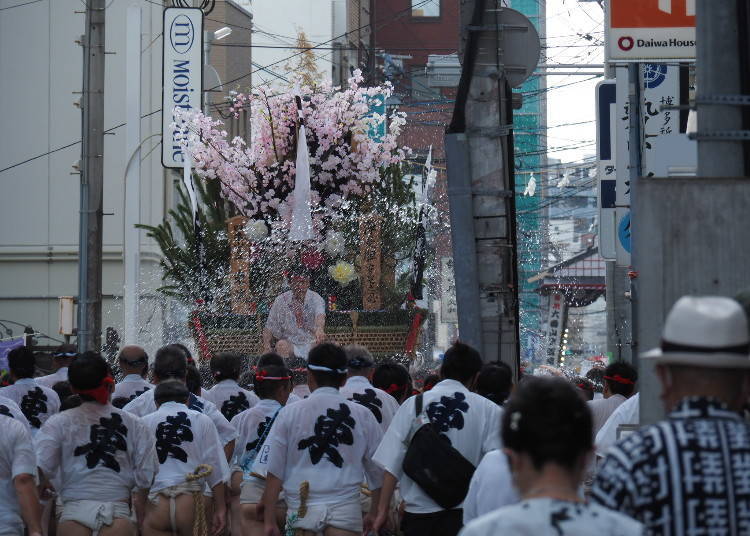
Overview:
This is a Shinto ritual in which Yamakasa (mikoshi-like ritual floats used in shrine festivals) are presented at Kushida Shrine, said to house the guardian deity of Hakata, Fukuoka Prefecture. The highlight is "Oi-yamakasa," which begins at 4:59 AM on the final day, July 15th. During this event, seven teams run their yamakasa through the town at dawn, aiming for their goal 5 kilometers away.
Festival Highlights
At the start of the festival, 14 elaborately adorned yamakasa are unveiled at various locations across Fukuoka City, centered around the Kushida Shrine. These yamakasa feature gorgeous dolls, with the front side facing Kushida Shrine, usually displaying warrior dolls, and the rear side showing subjects from popular anime.
Dates:
July 1-15
-
Kushida Shrine櫛田神社
- Address 1-41, Kamikawabatamachi, Fukuoka City Hakata Ku, Fukuoka, 812-0026
Japan boasts an incredible number of traditional festivals that have been celebrated since ancient times. Whether the theme is snow, lively dancing, or participants bearing mikoshi, each event bestows the town with an air of excitement and a shared sense of unity, regardless of nationality. If you happen to find yourself in Japan during the season of any of these celebrations, be sure to experience the festivities for yourself!
*Information in article as of September 2023. Please see official websites for the latest updates and information.
English translation by: Krys Suzuki
- Category
*Prices and options mentioned are subject to change.
*Unless stated otherwise, all prices include tax.
Popular Tours & Activitiess
Recommended places for you
-
Appealing

Rukku and Uohei
Izakaya
Sapporo / Chitose
-
Goods

Yoshida Gennojo-Roho Kyoto Buddhist Altars
Gift Shops
Nijo Castle, Kyoto Imperial Palace
-

ISHIDAYA Hanare
Yakiniku
Kobe, Sannomiya, Kitano
-

Kanzenkoshitsuyakinikutabehodai Gyugyu Paradise Sannomiya
Yakiniku
Kobe, Sannomiya, Kitano
-

Kambei Sannomiyahonten
Yakiniku
Kobe, Sannomiya, Kitano
-

Jukuseiniku-to Namamottsuarera Nikubaru Italian Nikutaria Sannomiya
Izakaya
Kobe, Sannomiya, Kitano
-

(12% OFF KKday Coupon) Mt. Fuji Autumn Leaves, Powder Snow & More! 15 Best Tours to Experience Japan in Fall & Winter
-

10 Must-Buy Cosmetics at Don Quijote (2025 Edition)
-

Fine Dining on Rails? Japan Announces Stunning NEW 'Laview' Restaurant Train
-
Ad

Walk in the Footsteps of Believers: A 4-Day Pilgrimage Across Goto City
by: Yohei Kato
-
Ad

Okinawa Travel Troubles? Guide to the MCC Hotline for Illness and Weather Emergencies
-
Ad

Get Your Perfect Custom Suit at GINZA Global Style PREMIUM Ginza Honten: Choose from 5,000 Fabrics, Starting at 26,400 Yen (incl. tax)!
-

Akita Kanto Festival 2025: Thrilling Acrobats, Illuminated by 10,000 Lanterns - One of Northeastern Japan's Biggest Festivals
-

4 Best Tokyo Festivals in March: Fun Ways to Greet Spring
-

Sanja Matsuri: Inside Guide to One of Tokyo’s Most Famous Festivals
-

Festivals in Japan: Month-by-Month Guide to Enjoy Fireworks, Dances, and Seasonal Events
-

Tokyo to Sendai: Riding the Shinkansen to Japan's Stunning Spots
-

Dining in Kyoto: Best Restaurants for Kaiseki, Sushi, Cafes & More
- #best sushi japan
- #what to do in odaiba
- #what to bring to japan
- #new years in tokyo
- #best ramen japan
- #what to buy in ameyoko
- #japanese nail trends
- #things to do japan
- #onsen tattoo friendly tokyo
- #daiso
- #best coffee japan
- #best japanese soft drinks
- #best yakiniku japan
- #japanese fashion culture
- #japanese convenience store snacks
















